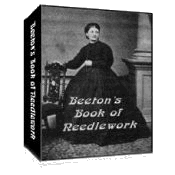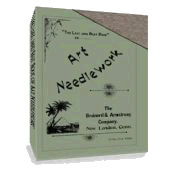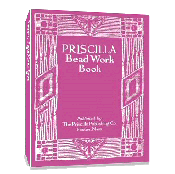Embroidery Needles
How to select the right needle
for your project.
An item to claim attention of any embroiderer is the matter of needles, and be sure this is a very important item in the embroiderer's outfit, as upon the use of proper needles depends much of the beauty of the work. Frequently, too little thought is given such a small object, but with embroidery, it is often the small things that count. Proper selection of this item will, without a doubt, increase the speed of the embroiderer as the silk, floss or wool will not become tangled or snagged in the eye. Proper selection also will retain the beauty of the foundation cloth by making the correct size hole needed for the embroidery material, whether silk, floss, wool or anything else an imaginative embroiderer might use.
For embroidery on fine material, a long, slender needle with sharp point is better than a short, blunt one. Novice embroiders, as well as many experienced embroiderers, find a blunt needle useful when cross-stitching as it will not pierce the cross-stitch fabric in inappropriate places unless undue force is used. This enables the embroiderer to proceed quickly with her project. No matter the project, there should be at hand a supply of needles of various sizes, both round eyed and long eyed.
The best needle for embroidery is one which has a smooth eye that allows the silk plenty of play, without pulling it to pieces or roughing it in the least. A needle too coarse or too fine will be sure to prove a source of constant annoyance. If the eye be too small, the silk cuts and frays, because it gathers in a thick lump at the eye of the needle, which has to be forced through the fabric to the detriment of the silk. If the eye be too large, the work takes on the appearance of having too few stitches, and holes mark the edges of every stitch.
Victorian ladies were given the following tips from accomplished embroiderers.
- It has been found from experience that a No. 9 or No. 10 needle is especially well adapted for general use.
- Arrasene needles are best for carrying chenille, arrasene, ribbosene, rope silk, art silk, Bargarren linen and rope linen.
- The needle for working with Bargarren linen should be two sizes larger than that for carrying rope linen
- The needle for carrying wool arrasene should have a larger eye than the one employed in carrying silk arrasene or rope silk.
- It is better to have a needle too large than too small for such threads as Bargarren arrasene and chenille.
- For embroidering with etching silk, filo floss, wash twist, linen floss and embroidery cotton a round-eyed needle should be used.
- A No. 9 needle is best for filo floss and linen floss.
- Nos. 9 and 10 are the proper sizes for one thread of Filo Selle, which is to be embroidered into linen lawn, grass linen or bolting cloth.
- For ready stamped linens, use a No. 8 or No. 9 needle.
- On heavier linens, use a No. 8.
- "Caspian" Floss and Outline Silk require a No. 8 needle
- Butchers' linens or fabrics mounted over linen, requires the use of a No. 7.
- No. 7 is the size for heavier work in two threads of Filo Selle.
- "Roman" Floss requires a No. 4 needle.
- Rope Silk takes a No. 4 needle.
- In Mountmellick Embroidery, one should use the coarser sizes. A No. 7 is required for Mountmellick Silk size FF; No. 6 for size F; No. 5 for size G; and No. 4 for size H.
- In shading, where a number of colors have to be used alternately, an experienced embroiderer will not confine herself to one needle which has to be threaded and re-threaded with the different colors, at a considerable loss of time, but she will have a needle for each color and use them in succession, as each color is required in her work.
- In working upon certain materials, it may be advisable to select some sizes different from those mentioned above.

Victorian ladies could, as ladies can today, purchase packages containing assorted sizes. One could order the sizes shown in the picture, as well as size 5/10 which means that there were 25 needles in a paper of assorted sizes ranging from sizes 5 to 10 inclusive. Also available were 3/9 size, meaning the paper contained sizes 3 to 9 inclusive.
Easy Steps for Choosing the Correct Needles
For Today's Needlework.
- Determine what fabric you wish to work on. If the weave is tight, such as with cotton or synthetic blends, a sharp needle will be required. If working on an loose weave such as canvas used for cross-stitch or needlepoint or linen, you may choose to work with a blunt needle.
- As you will want to use the smallest eye possible for your project, the next step would be to decide what medium you will be using to put a design on your fabric. Pick a needle with an eye that will easily hold the medium without roughing or snagging it and allows it to flow easily through the fabric. Usually a pattern will tell you what needle size to use. If not, a little experimenting will be in order. Just remember, you want to use the smallest eye possible that will accommodate your medium comfortably and while still avoiding putting large holes in your project.
- Determine what your finished project is to be. Will the finished item be thick or thin? Thicker project will require longer needles than those of thin projects.
The following are good choices in needles for that particular work.
If you are:
- attaching beads to fabrics or other needlework, use a beading needle
- threading ribbon, drawstrings or elastic through fabric or other needlework casings, a bodkin is useful. Bodkins are available in flat and round form. A bodkin makes quick work of threading something through a casing and is much easier to use than a safety pin.
- working on a crewel embroidery project, crewel or embroidery needles are the preferred needles
- darning or mending wool, you will need darners, long, short or both
- embroidering or using a stamped cross stitch item, embroidery needles will prove invaluable. Embroidery needles have a longer eye which makes threading stranded cotton through much easier. The longer eye is the only difference between them and ordinary sewing needles. Note that some manufacturers package their embroidery needles under crewel. If the manufacturer of the needles you use does so, just be sure to choose the correct eye size.
- working on course fabric, a Chenille needle may be preferred. A chenille needle is identical to tapestry needle except it has a very sharp point.
- doing leather work, Leather needles are required. These needles have triangular point that pass through leather and suede without marring the surface.
- wanting to make decorative stitches or pleating, Milliners needles are the answer. These needles were originally used in the millinery trade (hence the name). The only difference between them and ordinary sewing needles is that millinery needles are longer.
- quilting, use needles especially designed for quilting. Quilting needles are shorter than ordinary needles which allow quilters to stitch faster.
- sewing garments or doing general sewing, Sharps are the needle to use
- making a counted cross stitch and needlepoint item, a blunt tapestry needle is required. Tapestry needles have large eyes which allow room for tapestry wool or six-stranded cotton. The blunt end enables the needle to be used without damaging the canvas.
When you purchase needles, they are labeled for their intended use such as beading or darning needles. You may find it useful to try different needles to see if, although you might not think it is the "proper" needle, it works well for your application. There are no hard and fast rules for picking the correct needle. The bottom line is, whatever works best for you is the needle for you to use. Experimentation and experience will be your best teacher on what needle is correct.
Return to top of Embroidery Needles page.
Return to Hand-Embroidery page.
The Last and Best Book of Art Needlework
Over 100 pages of authentic Victorian instructions and patterns from 1895!
FREE
Beeton's Book Of Needlework

433 pages!
Sign up for VEAC! Everything you wanted to know about Victorian embroidery, needlework, crafts and more!
Priscilla Bead Work Book
Make Beautiful Victorian Beaded Purses, Jewelry & Accessories - Starting
TODAY!



